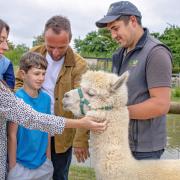With the UK due to leave the European Union in less than a year, the rural economy in the Cotswolds is bracing itself for change. Lucy Parford looks to the future
As a thriving region it is well placed to respond positively to whatever the future may hold. Just a few years ago, Gloucestershire topped The Country Land and Business Association’s Rural Business County League Table as the best location to run a rural business in the South West and it continues to prosper.
According to the NFU, Gloucestershire has over 3,000 commercial farm holdings and directly employs over 7,000 people in agriculture. This creates a strong economic force which contributed £318 million Gross Output to the county’s economy in 2011.
There are over 200,000ha of farmland in Gloucestershire and of this 60 per cent is managed as grassland. This is 10 per cent higher than the national average and reflected in the fact that the county has nine per cent of the cattle, 11 per cent of the sheep and seven per cent of the pigs in the South West.
In addition, it has 15 per cent of the South West’s poultry and the remaining arable land produces 18 per cent of the region’s cereal crops.
The English farmland market showed remarkable resilience compared to other asset classes during the recession, particularly in Gloucestershire and other parts of the Cotswolds.
According to Knight Frank, price growth for land in Gloucestershire over the past five years has increased by 36.5 per cent, compared to 34.3 per cent for the whole of the UK. In the last year, to December 2017, it has grown by 8.5 per cent, compared to 5.2 per cent nationally.
In neighbouring counties the price growth over the past five years is 35.6 per cent for Warwickshire, 33.4 per cent for Oxfordshire and 29.9 per cent in Worcestershire.
However property consultants Bruton Knowles, which has its headquarters in Gloucester, has warned land prices in the South West are so volatile the price can vary by as much as 50 per cent from one field to the next.
Matthew Peters, from Bruton Knowles’ rural team, said: “With so little coming on to the market it’s difficult to predict exactly what land will go for.
“While the latest RICS/RAU Rural Land Market Survey reports that headline demand is broadly stable, we are seeing tremendous regional fluctuations – with local hotspots returning strong prices.”
Matthew said people who had sold development land were always in the market, but people with land to sell might be lucky to get top price.
“As always, low quality, poorly located land won’t sell well as it has lower earning capacity,” he explains.
“As an example, one block of land we sold made £13,000 per acre but the land next door only made £7,000 per acre because it didn’t adjoin the buyer’s farm. It was of a similar quality.
“Having said that, some areas around Gloucester, Cheltenham and Swindon are going well and there are people with money in the marketplace.
“But within these areas there will also be spikes where you cannot sell for any money. All this means it’s very difficult to offer any kind of comparison.”
Bruton Knowles says smaller parcels of land are still proving popular with lifestyle buyers or equestrian families.
There are a number of new initiatives which also make Gloucestershire an attractive place to be based and are helping the rural economy to flourish. As part of its Strategic Economic Plan for Gloucestershire, GFirst LEP opened Farm491 last summer, a state-of-the-art space for agri-tech innovators.
Farm491 offers start-up space on-site at the Royal Agricultural University’s main campus in Cirencester and at the farm-based workshops at Harnhill. Its members have access to business support and a knowledge network that includes farmers, investors and expert advisers, as well as open access to farming data.
It plans to assist over 55 new agri-tech companies and help them create over 200 new jobs over the next five years.
Hartpury College has also just been awarded £1million of Growth Deal funding towards a ‘Tech to Plate’ concept. The programme consists of an Agri Tech Centre aimed at using applied technology in livestock production to maximise productivity and quality through the application of precision farming techniques – ‘smart farming techniques’.
In effect using technology to improve productivity whilst also measuring impacts all the way to the consumer’s plate.
Speaking about the project, Diane Savory OBE and Chair of GFirst LEP, said: “The rural economy is an important sector for the county and we are delighted to be able to support this project.”
Research by Rural England shows that greater use of digital tools and services could deliver as much as 8.8 per cent of additional Gross Value Added for the rural economy too. Annual business turnover in rural areas could grow by at least £15billion, with rural microbusiness and small-sized business seeing the greatest returns, it suggests.
The report, sponsored by Amazon, outlines five themes for the private and public sectors to help support this opportunity. They include Rural Digital Enterprise Hubs, training and skills development and future support programmes targeting digital growth for rural businesses.
The report found that the South West, Eastern and South East regions, which have the largest share of rural businesses in the country, are set to benefit the most from greater digital adoption.
Countryside Alliance head of policy Sarah Lee said the report showed that a rural digital strategy should be central to the Government’s plans to create a stronger economy.
“Achieving full connectivity, investing in skills development and encouraging more rural businesses to maximise the digital opportunities already in existence will enable rural communities to achieve their full economic potential,” she said.
Despite the uncertainty of Brexit, rural businesses are being urged to make the most of grant funding while it is still available under the LEADER programme, part of the Rural Development Programme for England (RDPE) which is funded by the European Agricultural Fund for Rural Development (EAFRD).
Grant decisions are made locally by an appointed Local Action Group of key representatives from various organisations in the local area. The Cotswolds LEADER Grant Funding Programme is delivered by the Cotswolds Conservation Board.
The aim of the programme is to create new jobs and grow the rural economy through capital grant investment. The programme is open to a wide range of businesses, farmers and not for profits.
The LEADER priorities of generating jobs and growth cover: increasing farm productivity, micro-enterprises and farm diversification, rural tourism, culture and heritage, rural services and increasing forestry productivity.
The Cotswolds LEADER programme is still open for applications, with a cut-off date for Expressions of Interest by September this year.
Farm diversification - adding business activities to traditional farming to develop new sources of income – is an option which is becoming more and more popular. According to the Government, about half of all UK farms use some form of diversified activity in their farming business.
With supermarkets and consumers turning away from eggs from factory hens, free-range egg production could offer opportunities for farmers struggling with sheep and dairy enterprises as demand grows.
Bruton Knowles’ rural sector specialist, Gareth Lay, has seen an increasing amount of farmers looking into free-range production or expanding units as they gear up for changes in farm support after 2022, when subsidies at the current EU level will end.
He said: “Supermarkets such as Waitrose and the Co-op are leading the charge for free-range eggs, along with big chains such as McDonalds.
“It is a really interesting marketplace and an area where we are doing increasing amounts of work.”
While many may be considering diversifications, such as holiday lets or farm shops, Gareth said free-range hens did not require a complete change of lifestyle, although it might need high levels of borrowing.
“While the costs are fairly high to start, there are high rewards. Returns from the sector are significant given the fairly small area of land required,” he said.
“New sheds cost anything from £700,000 to £1.2 million for units to house 16,000-32,000 birds respectively.
“This business model suits farmers who have land and are struggling with existing enterprises such as sheep and dairy.”
Oxfordshire has ambitions for substantial economic growth and development, driven by its own Strategic Economic Plan (SEP), led by Oxfordshire Local Enterprise Partnership (OxLEP) and its partners.
Part of the plan is dedicated to supporting rural diversification and resilience. Over 70 per cent of the Oxfordshire landscape is in use as farmland, with agricultural goods and services worth £91 million per year and employing around 2,300 people across the county.
The SEP states rural diversification is important for the economic sustainability of farming and rural communities, to obtain the maximum value from rural assets, benefit from multiple income streams and reduce exposure to risk.
Farm shops, farmers’ markets and other initiatives to promote local food sourcing have the potential to add value to farm produce. Renewable and low carbon energy is another option for generating additional income in rural areas, as well as reducing energy bills and environmental impacts.
Rob Panting, Communications Manager at OxLEP, said: “Oxfordshire’s economy is a driving force behind ‘UK PLC’ and our rural strengths play a vitally important role in contributing to a successful economy.
“In addition to our natural assets – such as the Cotswolds, where tourism clearly plays a key role – many of our rural-based businesses are of global significance, operating across a range of sectors including automotive, life sciences and space technology.
“Our key role – through our Strategic Environmental Economic Investment Plan – is to support the growth of the ‘green economy’ in Oxfordshire; including our strengths in farming, forestry, low carbon energy and environmental research and services.”
Investment proposals identified by OxLEP include a range of business support, including training, apprenticeships, collaboration and business incubation for farming and land-based activities at a new EarthLab centre at Earth Trust’s farm at Little Wittenham, Abingdon and a project to encourage networking and collaboration between Oxfordshire’s universities and businesses in the food, energy and water sectors.
A programme of support is also proposed for businesses in the Lower Windrush Valley to enable them to benefit from tourism and leisure opportunities around newly-created freshwater habitats in former mineral extraction sites.
Other major developments in the pipeline in Oxfordshire include an ambitious 10-year plan for Blenheim Palace, announced last year. The programme, which is being led by Blenheim Palace’s CEO Dominic Hare, includes tripling the Estate’s contribution to the local economy, housing 300 families in high-quality affordable housing, completing a £40m restoration programme and becoming a net generator of green energy over the next 10 years.
Dominic said: “We believe there is no possible vision for a future successful and flourishing Blenheim which does not depend on a flourishing and successful set of communities around it – and the same is true in reverse.”
Key to the success of the rural economy is affordable housing and making it an attractive option for young people to stay and work, rather than leave for urban areas.
According to the Statistical Digest of Rural England, there has been a steady increase in house-build completions by Local Authorities/Housing Associations in predominantly rural areas. New-build dwelling completions accounted for 87 per cent of such net additions to the housing stock in predominantly rural areas in 2015/16, compared with 80 per cent in predominantly urban areas.
New-build dwelling completions per households in predominantly rural areas are also higher than in predominantly urban areas. In 2015/16 there were 8.6 new-build dwelling completions per 1,000 households in predominantly rural areas, compared with 6.5 in predominantly urban areas.
The Government recently published a consultation on the draft revised text of the National Planning Policy Framework (NPPF) which contains a number of changes that will see increased opportunities for building much-needed homes for village communities and creating opportunities for business growth and change.
President of the CLA, which represents landowners, farmers and rural businesses, Tim Breitmeyer said: “Housing need is widespread throughout rural England so it is good to see the Government recognise the specific needs of those in the countryside and be bold in its approach to addressing them.
“The CLA has long argued that in the right circumstances, land outside of existing settlements can play an important role in meeting the housing and business needs of a rural community. By backing this policy, the Government is showing a marked shift in its attitude to how planning authorities should treat development opportunities.”



























